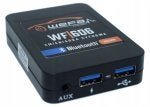My intended purpose for this project was primarily to provide a means to charge my phone. Obviously I can use it for making hands-free calls via Bluetooth but you can imagine the futility of trying to have a conversation on the autobahn with the top down.
I had initially considered installing a 12V-USB port under the center console with a charging cable routed into the center tray. But I don't want to have to worry about my phone being left unattended when the top is down and I go in to pay for gas. Also, in just normal driving, leaving the phone in the sun is not doing it any favors either. So keeping it in the glove box, out of sight and sun, made more sense.
I don't use the CD changer anyway so getting a bit more storage space was an added benefit. And I don't intend using the BT-1701 USB port to provide music to the RNS-E since I keep all my music on SD-cards, but I'll have to try it and see how that feature actually works.
Bluetooth Streaming Box 1701 (USBN17) from USB-Nachruesten.de.
For reference, my 2007 Roadster was fitted with the following equipment -
Project Quick Links
As delivered from USB Nachruesten -
![Image]()
Bits inside the package -
![Image]()
The case shown here on the LLLParts website, is item #5 Part Number: 8P0035113. You can find it on Amazon and eBay for around €25 - 35. I bought mine directly from Audi Parts for less than €20, so why buy it from a re-seller?
![Image]()
![Image]()
Installation instructions are attached here for reference. Be sure to download the latest instructions from their website in the event there have been any changes or updates -
.
I had initially considered installing a 12V-USB port under the center console with a charging cable routed into the center tray. But I don't want to have to worry about my phone being left unattended when the top is down and I go in to pay for gas. Also, in just normal driving, leaving the phone in the sun is not doing it any favors either. So keeping it in the glove box, out of sight and sun, made more sense.
I don't use the CD changer anyway so getting a bit more storage space was an added benefit. And I don't intend using the BT-1701 USB port to provide music to the RNS-E since I keep all my music on SD-cards, but I'll have to try it and see how that feature actually works.
Bluetooth Streaming Box 1701 (USBN17) from USB-Nachruesten.de.
For reference, my 2007 Roadster was fitted with the following equipment -
- RNS-E (192)
- 6-CD Changer in the Glove Box
- Bose Sound System and Amp
- OEM Phone kit in center tray (since removed)
- No AUX connection in the center console
- 32-Pin connector supporting video box for my reverse camera
• VAG head unit removal keys (x4)
• Small flat screw driver
• Small Philips screw driver
• Electrical cloth tape
• Small cable ties
• Connector de-pinning tool
Project Quick Links
1. CD Changer Removal
2. Case Prep
3. RNS-E Removal
4. BT-1701 Installation, Set-up and Test
5. Tips and Tricks for Installation
6. Connecting Cables and Final Installation
As delivered from USB Nachruesten -
Bits inside the package -
The case shown here on the LLLParts website, is item #5 Part Number: 8P0035113. You can find it on Amazon and eBay for around €25 - 35. I bought mine directly from Audi Parts for less than €20, so why buy it from a re-seller?
Installation instructions are attached here for reference. Be sure to download the latest instructions from their website in the event there have been any changes or updates -
.








